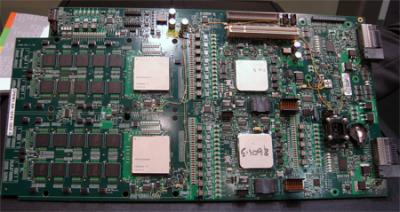IBM shows Cell blade in action

IBM has showed off a prototype blade server based on the Cell processor in action this week.
The company demonstrated the Cell blade server running visualisation software to display real-time three-dimensional video footage of a beating heart at the CeBIT show in Hanover.
This allows a researcher to rotate the image of the heart and observe it from any angle, or filter out elements such as blood or certain tissue to give a transparent view into the centre of the heart.
This requires a huge amount of data processing, but a blade server using the nine-core Cell chip is well equipped to handle such a workload, according to Utz Bacher, team leader for IBM's Linux on Cell development team.
"Conventional computers find it very hard to cope with tasks such as transparency," Bacher told ZDNet UK. Bacher added that a Cell Blade server running visualisation software would also be very useful in the oil industry, where companies want to filter masses of data in search of geological structures indicating oil deposits.
The Cell chip, which was designed by IBM, Sony and Toshiba, will also power Sony's PlayStation3 games console. It contains a PowerPC 970 processing core and eight DSP cores, which handle graphics or vector calculations. Each IBM Cell blade contains two Cell chips, with 1GB of DRAM shared between them.

The two Cell chips are the white squares on the left hand side of the board, next to their 1GB of DRAM. This is a display model — the sticky tape and wires are not part of the working Cell board.
Each Cell blade is twice the width of existing IBM blades so only seven will fit in a single blade chassis, rather than the 14 non-Cell blades that can currently be fitted. The chassis displayed at CeBIT contained six Cell blades.
The Cell blade servers are contained in the top half of the rack
IBM is planning to launch the Cell blades commercially in the third quarter of this year. Pricing isn't yet available. It's also not clear exactly what the performance increase will be compared to existing blade servers, although Bacher suggested it could be a order of magnitude increase.
Bacher explained that when a single Cell chip runs at 4GHz, it provides 250 gigaflops of computational power. With two Cell chips per blade, this means that a single blade could handle 500 gigaflops.
However, the Cell chips in the system on display at CeBIT were running at 2.4Ghz. Bacher said the commercial unit would run at between 2.4Ghz and 4Ghz.
There are several ways that IBM could improve the performance of the Cell blade in the future.
"Right now, we use a 90nm manufacturing process for the chip. We could lower that to 60nm, 45nm or 30nm," said Bacher, adding that IBM could also increase the amount of memory within each blade.